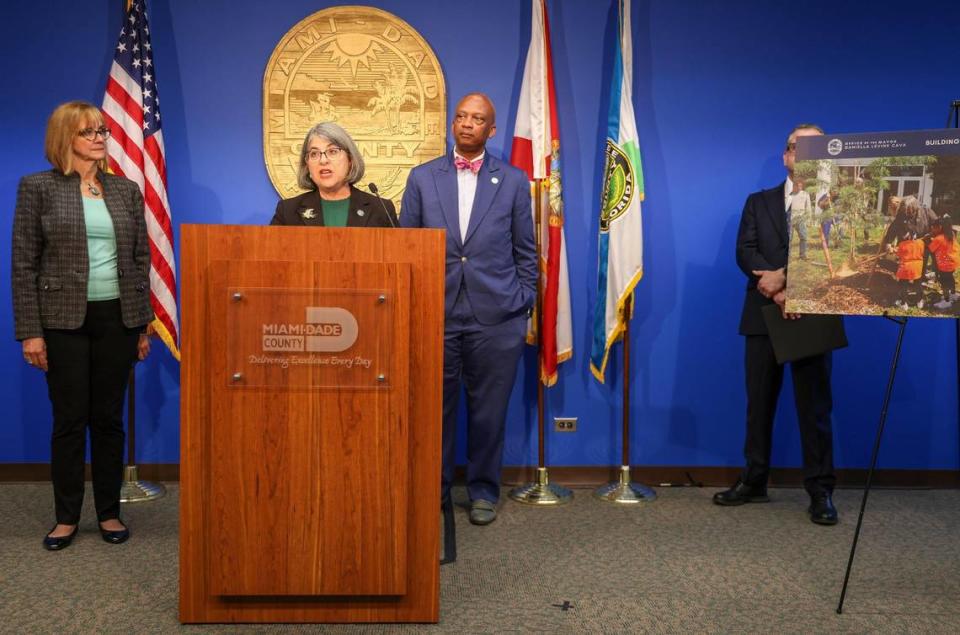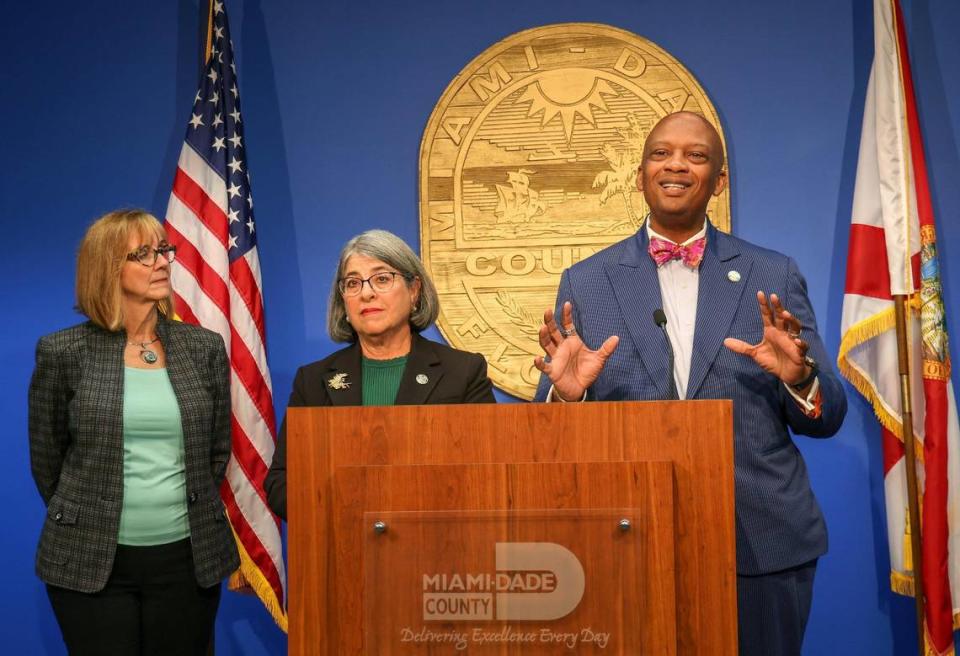Miami-Dade has its first $11 billion budget. Why a lower tax rate won’t cut spending
A surge in property taxes is helping fund Miami-Dade County’s first budget proposal to top $11 billion, despite Mayor Daniella Levine Cava proposing a 1% cut in the countywide property-tax rate.
With real estate values booming and other revenue sources on the rise in Miami-Dade, Levine Cava on Monday unveiled the largest spending plan in county history as she gears up for reelection in 2024.
READ MORE: Miami-Dade mayor proposes rare tax rate dip. Here’s what that means for homeowners
“This is a smart, compassionate and future-ready budget,” Levine Cava said at a press conference in the Stephen P. Clark government tower unveiling her $11.7 billion budget proposal up for its first vote this week ahead of final approval in September. “The proposed 1% tax cut will provide immediate relief to residents, while also ensuring your county can continue to provide essential services.”

Because Florida allows appraised values to increase 3% this year, most homeowners would see their tax bill grow even with the proposed drop in the countywide rate from $462 for every $100,000 of taxable value to $457.
READ MORE: Oops: Miami-Dade forgets to renew gas tax. Drivers get savings, county loses millions
Levine Cava’s budget has an extra an $283 million in property-tax revenue compared to the current budget year, which ends Sept. 30. Add in other revenue sources — including fees paid by cruise ships and airlines at PortMiami and Miami International Airport — and the 2024 budget proposal grows by $1.3 billion, a 12% increase.

County commissioners on Tuesday advanced Levine Cava’s tax plan by approving her proposed rates as the maximum rates for the 2024 budget. Final rates will be voted on in September, but the Tuesday decision effectively locks in at least a 1% reduction in the countywide tax rate.
Commissioners balked at approving a proposed $36 increase in yearly trash fees to cover a deficit in the Solid Waste Management Department’s budget. That rate decision will also be made during the September budget process.
Some highlights of the budget include:
▪ Miami-Dade’s public safety spending is set to grow by about $300 million. That 17% boost includes budget increases for Corrections (12% to $483 million), Fire Rescue (9% to $722 million) and Police (8% to $948 million).
▪ County employees will be earning more. The mayor’s budget has an automatic 3% raise for a workforce of about 30,000 people starting on April 1. Overall staffing costs increase about 8% to $317 million. The budget adds more than 700 positions, to a total payroll of 30,805 jobs.
▪ Miami-Dade is out millions of dollars because the Levine Cava administration failed to meet a state deadline to renew a six-cent gas tax that generates more than $40 million yearly for local road projects. The tax will lapse from September through December before starting again in January. Levine Cava’s office said the cost will be about $16 million in revenue for the 2024 budget. On Monday, Levine Cava called it a “gas tax holiday.”
▪ More dollars for transit projects. Miami-Dade plans to spend more than $200 million in 2024 on three planned transit projects waiting to get off the drawing board: commuter rail on Brightline tracks along U.S. 1; an elevated extension of Metrorail along Northwest 27th Avenue; and either a rapid-transit bus line or rail system along State Road 836. While those projects have more than $50 million in the 2024 budget, the planned $1 billion Metromover extension from Miami to Miami Beach only has $6 million in the transit spending plan.
▪ Signs of financial challenges ahead. The county budget for police patrols and other municipal services outside city limits is facing long-term deficits starting in 2025 as expenses exceed revenue generated by the unincorporated-area property tax. Miami-Dade also projects a deficit for the county’s transit system in 2028 without nearly doubling the more than $200 million that comes from property taxes and other local sources needed to close gaps from the county’s half-percent transportation sales tax.
▪ The 13-member County Commission receives an extra $7 million for its current $34 million budget to cover a 50% increase in staffing with 61 new positions for a staff that currently sits at about 115 people. Oliver Gilbert, the commission’s chair, said the proposal corrects past budgets that didn’t provide enough staff for commissioners to accommodate Miami-Dade’s growing population. “We have staff struggling to keep up with citizens’ requests,” he said. “It’s a problem.”
▪ Dwindling sources of federal COVID aid means some revenue gaps in the budget. The budget doesn’t renew non-profits grants funded by federal COVID dollars for non-profits like the Dade Heritage Trust, the Haitian American Chamber of Commerce. and Citizens Crime Watch. The biggest impact can be seen in the Corrections spending plan. Corrections needs an extra $188 million from property taxes and other local sources this year. In 2023, the agency received $135 million from American Rescue Plan dollars, but this year those federal dollars are gone.
▪ While non-profit grants aren’t renewed with COVID dollars, the Levine Cava budget does have more spending for charities. Funding for community based organizations under county contracts increases 22% to $70 million.
▪ An extra 20 positions are added in Solid Waste to tackle Miami-Dade’s illegal dumping problem, where piles of trash are left on streets and roadsides.
▪ Almost $90 million for PortMiami to pay for equipment needed for cruise ships to turn off their generators and use shoreside generators. It’s part of a spike in overall capital spending countywide in the 2024 budget proposal. Levine Cava’s proposed capital budget of $4.4 billion is about 20% higher than the current year’s. She said state and federal infrastructure dollars are helping boost county spending on long-term projects.
This story was updated to include actions of the county commission on Tuesday.

 money
money 